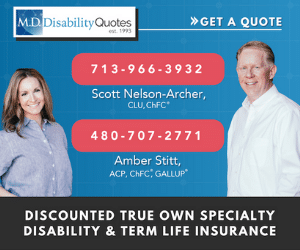6 Ways Optometrists Can Reduce Disability Insurance Premiums

Editor’s Note: This is a guest post written by our trusted partners Scott Nelson-Archer, founder of M.D. Disability Quotes, as well as his partner Amber Stitt, who provide exclusive disability insurance contracts for optometrists .Aaron and Dat are extremely strict about guest requirements in that they must be educational and informative to our readers. Every guest post is vetted, read and upheld to the highest standards of ODsonFinance. Your trust is the most valuable factor to us. We like having experts in their field write on our website, enjoy and give us feedback!
KEY POINTS:
-
(1) Contract Definition: Have a definition that matches your occupation more appropriately
-
(2) Premium Structure: Have a premium structure that fits your path to Financial Independence
-
(3) Select a Waiting Period and Extend it!
-
(4) Know Contract Differences: Understand the difference in having a Non-Cancelable and Guaranteed Renewable policy vs. just a Guaranteed Renewable policy
-
(5) Remove Extra Riders: Remove low value riders like COLA and Catastrophic
-
(6) Ask for Discounts
In today’s world there are so many things we need to get in place to help protect ourselves and our families; yes, disability insurance is one of them. Now I am a firm believer in making these contracts efficient and simple. This is not your new fancy car with all of the bells and whistles. In my opinion, it is just an insurance policy that you will hopefully never use.
(Step 1): Have a definition that matches your occupation more appropriately
Almost 100% of the folks we speak with are told to have the True Own Specialty definition of disability. In reality, the way one should look at this is to think about his/her occupational duties and then reflect on: 'If I become so disabled that I cannot do my Own Occupation, what other occupation(s) can I still then do?'
If you are a Primary Care optometrist, you could be buying a feature that one cannot fully utilize during a claim. Having the Own Occupation - Not Engaged definition is typically about 15% in savings.
Most sub-surgical specialties like Emergency Medicine or Anesthesia should probably stick to the True Own Specialty language, but all others should at least explore this savings option.
Financial Pearl
"Selecting the Own Occupation - Not Engaged definition as an primary optometrist is typically about 15% in savings"
(Step 2): Have a premium structure that fits your path to Financial Independence
There is the typical fixed premium with no potential for adjustments structure which is fine, but there are also other structures you should evaluate.
-
(A) Step Rated Premium
Policies that are compressed premiums from the fixed rate for the first 5 year and then in year 6 they have 1 premium increase which then becomes fixed for the balance of the policy life. This saves about 20% of your premium to start with.
-
(B) Projected Level Premium
These policies could have a rate change if the company had multiple years of losses in excess of their anticipated loss ratios and have received state department of approval for the change. If approved, the carrier would then change all policyholders' rates in that state. That would raise the rates by about 25% just to get back to the fixed rate pricing. Those products came out decades ago and they have never had a rate change anywhere in the country. This will create about a 16% premium savings.
-
(C) Graded Premiums
Is just a more palatable name for Increasing. These rates typically go up by 4-6% every year while in your 30’s, 6-10% per year while in your 40’s and 10-15% per year while in your 50’s. By age 60, you typically are paying about 6-10x what your original premium was. Where this can be punishing later in the policy life, in the near term it can create a good deal of premium savings when money is tighter. This will create about a 40% premium savings the first year of the graded premium, but of course that savings is going to diminish as the premium goes up over the coming years.
(Step 3): Extend the Waiting Period
Everyone thinks about this as it is typically presented to them by an agent traditionally in a 90 day waiting period, but by waiting an extra 90 days (180 in total) until payments to the insured start can save between 10-16.5% in premiums. Most have either built up PTO, Account Receivables, or Personal Savings which can bridge the gap if an illness or injury happens to them.
Financial Pearl
"Most optometrists have either built up PTO, Account Receivables, or Personal Savings which can bridge the gap if an illness or injury happens to them, which allow them to wait an extra 90 days, hence saving 10-16.5% in premiums"
(Step 4): Understand the difference in having a Non-Cancelable and Guaranteed Renewable policy vs. just a Guaranteed Renewable policy
Having a Non-Cancelable contract is nice in that the carrier can never change the rate but a Guaranteed Renewable rate is just that ‘Guaranteed Renewable.’ With a Guaranteed Renewable policy, the carrier still cannot cancel the policy on the insured. The only thing that can happen in a Guaranteed Renewable rate, is that the carrier can change the premium an insured is required to pay. In order to do an increase, the carrier must go to and be approved by the governing State Department of Insurance and then the carrier must apply that rate change across the entire body of insureds in that state. This savings is about 16-17% of total premium.
(Step 5): Remove low value riders like COLA and Catastrophic
COLA
One can take the same premium load that the COLA rider costs and simply buy more base benefit day one vs.spending that premium on the COLA rider. Since it takes about 10-14 years ON Claim for the cumulative benefit payout to the client to equalize, some opt out of the COLA rider all together. Additionally, COLA only activates once someone is on claim so there is no growth to the base benefit until 12 months of disability is met. When you then look at the duration of claims, it is about 1% of all claims that will exceed 14 years in duration. In summary, the probabilities are not with the client on this rider. This rider usually has a premium expense to the client of 12-25% depending on the carrier.
CATASTROPHIC
Provides you a monthly benefit in addition to your standardized monthly disability benefit (and Social Insurance Substitute Benefit if on the policy). This can be triggered if you become disabled solely due to an injury or sickness AND you lose the ability to perform two or more activities of daily living (ADLs) without assistance; or you become cognitively impaired. Benefits could be paid if you are:
- ADL disabled: unable to perform two or more ADL’s without assistance (bathing, continence, dressing, eating/feeding, toileting, transferring); or
Cognitively impaired: measurable impairment to short-term/long-term memory; orientation to people, places, time; deductive/abstract reasoning that severely impairs the ability to function independently.
This savings is usually around $3 per month for every $1,000 of monthly benefit. Because this is so inexpensive, most insureds will accept it, but one should think about it. Because it is so inexpensive, what is the chance of that feature ever paying out? The reality is when one experiences those losses, it is usually much later in life and typically post age 65 when these policies typically have run out.
(Step 6): Ask for a Discount
There are tons of discounts available to pretty much every occupation out there. There are many discounts available, to most medical occupations out there. As an optometrist, MD Disability Quotes has preferred discounts available for you that can be locked in at approval. These discounts vary depending on the carriers and other factors such as age, gender and state of residency.
As a consumer buying a contract or a broker building the contract, the most important thing that can be done is to make sure the contract has the features and options to meet the insured's expectations at time of claim.
Language that misses the mark at claim time or an overloaded contract does not serve the client well. I like to balance policies based on probabilities vs. possibilities.
As you journey down the path of your disability insurance acquisition, let us know how we can help!
Need help trying to find the best Term Life Insurance or Disability? Check out Recommended Insurance Agents
Want to get a full blueprint on How to start? Read The Optometrist’s Guide to Disability Insurance


1